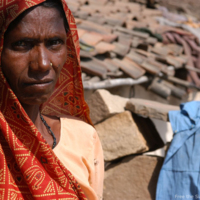
I moved to Delhi from Tripura (next to Bangladesh) in 2002 after the death of my father. I was a tailor in my village. When my father died, my uncle took all our lands and forced my family to move out of our house.
When we first came to Delhi there was not much work. I was only paid on a piece rate basis and that was not sufficient to look after my family, therefore I had to take loan from the factory owner. Within six months the debt had increased to Rs 8,000 [approximately GBP 114, or USD 182]
I had to borrow some more money when I arranged marriage for my daughter. In total I owed Rs. 40,000 to the factory owner.
I work around 13-14 hours a day and earn around Rs 5,000-6,000 per month when it is busy. I live in a single room with my family and pay Rs 1,500 per month as rent. I don’t have any option to leave until I have paid back the money to the factory owner.
Narrative provided by Anti-Slavery International from their report ‘Slavery on the High Street: Forced Labour in the manufacture of garments for international brands’, June 2012.









